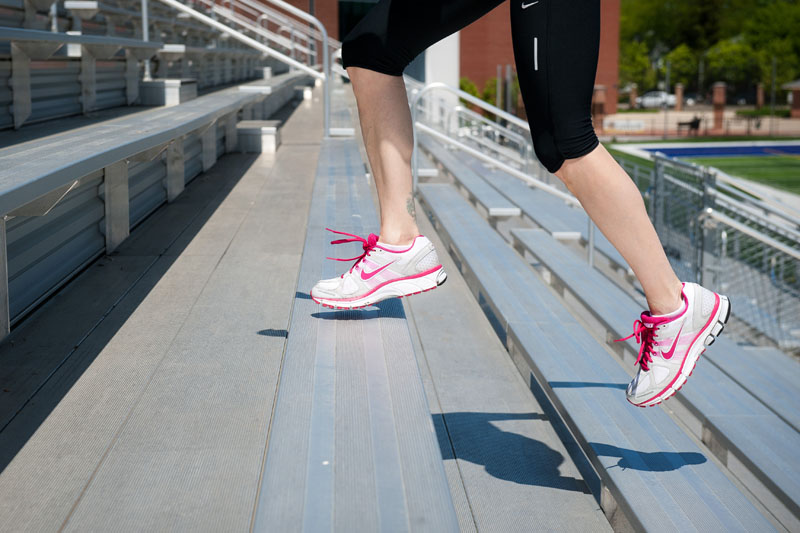by Carol Kelderman, PT, DPT
This is a great time to get some exercise and some fresh air! For many people, running provides far reaching health benefits including stress relief. The only equipment necessity is a good pair of running shoes. With so many different shoes to choose from, making the right selection can be tricky.

At Kinetic Edge Physical Therapy, we see a variety of runners. Some of them are just getting started, others are dealing with a limiting injury, and some are even looking to maximize their performance. The right running shoe can make a big difference for each of those categories of people. There are five main categories of shoes for the average treadmill or road runner based on the person’s type of foot and his/her need for stability or control.
Shoe Types
- Stability shoes offer a mix of midsole cushion and support with some control of over-pronation, a term we use to describe what happens when the foot’s arch drops toward the ground when weight is applied. Pronation is actually very normal, but too much or the inability to control this motion can lead to pain and eventually injury.
- Motion control shoes provide support for runners who have very flat arches and demonstrate significant over-pronation. These shoes tend to be more rigid with wider soles to help control the excessive motion of the foot and ankle. They provide the durability and high levels of stability that heavier runners may be seeking as well.
- Cushioned shoes give that extra bit of shock absorption but don’t have a lot of extra support or corrective features. These shoes are ideal for runners with little or no pronation, such as those with high arches or a rigid foot structure. For runners who are training for speed or running on rough trails, a couple other categories may be considered.
- Lightweight shoes are built for speed work. Racing flats and spikes fall into this category and are best for sprints, intervals, and shorter distance competitions. These shoes do not have cushion or support, but they are light and allow the foot to accommodate to the ground for rapid response.
- Trail shoes offer a blend of support, stability, and protection. Just imagine your running shoe merging with your hiking shoe. This shoe is designed for off road running adventures that need traction and support over the uneven terrain.
Shoe Selection
Many factors impact your shoe selection. Your foot structure and training goals are just the beginning. Your unique running mechanics is another major factor to consider. Running form issues tend to fall into two different categories: physical limitations and habit.
- Do you have weakness or tightness that limits normal movement patterns?
- Do you have running form habits that lead to movement inefficiencies?
If you answer yes to either of these or have never considered them, one of the Kinetic Edge Physical Therapy professionals could help point you in the right direction. When it comes to preventing a running injury or dealing with an existing injury, the importance of your running shoes is bound to be part of that conversation.
The right shoe can be such a victory. While that “perfect” shoe can help you run more comfortably and improve your efficiency, it may take some trial and error. A word of caution: Not all running shoe lookalikes are performance running shoes. Each brand makes “lifestyle” shoes that have similar appearance but not the same construction.
To reduce the guess work, shoe stores that specialize in running, have knowledgeable staff, and offer a place to try the shoe out on a treadmill or other surface are ideal. Kinetic Edge partners with several of these shoe experts who understand the features of each shoe as well as the year to year changes in the various performance running shoe brands like Fitness Sports, Fleet Feet, Brown’s Shoe Fit, and Running Wild. Above all, your running shoes should be comfortable straight out of the box and feel good on your very first run.
Runner’s World Tips
- It’s best to go to a specialty running shop (not a big-box or department store) where a salesperson can watch you run and help you select a pair of shoes that offer your feet the support they need.
- You may think you know your size, but it’s best to get your feet measured each time you buy new shoes. Your feet change over time, and one model’s fit can be drastically different from another’s.
- When you go shopping, take along the shoes, socks, and any inserts that you’ve been using. That way you can make a realistic evaluation of how well the new shoe will fit your feet.
- Shoes should be replaced every 300 to 500 miles. Keep track of the date that you bought them in your training log.
Running is a great way for many people to stay healthy in body, mind, and spirit. Choose your shoes wisely. Request an appointment with Kinetic Edge online or call us directly at 866-588-0230 if you would like a personalized assessment.



